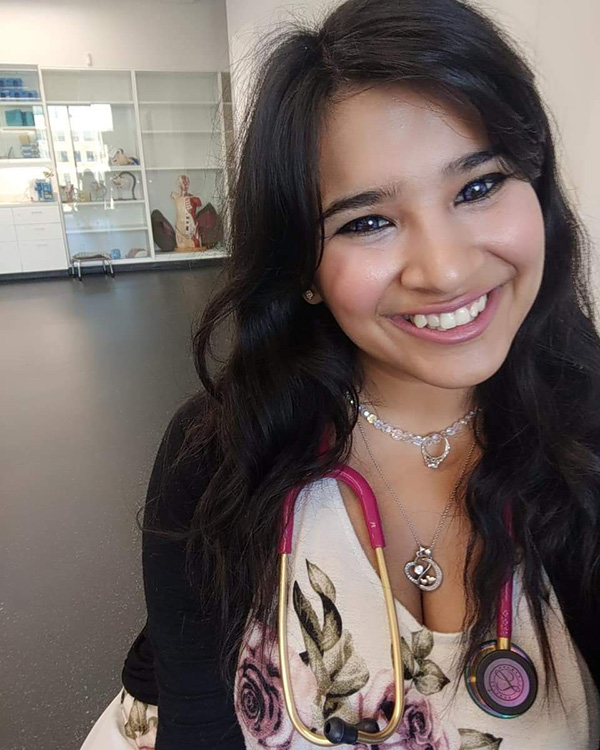For Ontario midwifery students, COVID-19 imposes new barriers

June 9, 2020
Maha Maryam is a midwifery student at Ryerson University. Maha is actively involved in student advocacy, including as the student representative on the Canadian Association of Midwives board of directors, as well as a member of the Student Midwives Association of Canada (SMAC/ACEPS), the Association of Ryerson Midwifery Students (ARMS) and the Ryerson Midwifery BIPOC (Black, Indigenous, People of Colour) Midwifery Collective. Juana Berinstein, Director of Policy and Communications at the AOM, asked Maha questions to understand the particular impact of COVID-19 on midwifery students.
AOM: When did you know COVID-19 would impact students?
Maha: First the WHO declared the pandemic (March 11, 2020) and then schools announced closures following March break. Many of us realized the impact COVID-19 would have on us, especially on our clinical placements. Initially it seemed clinical placements would continue but the situation changed quickly. There was uncertainty. Some of us spent the weekend of March 13-15, 2020 trying to attend as many births as possible, knowing placements would likely be suspended. Others had to prioritize the safety of immunocompromised family members by taking the weekend off call. All students were pulled from placement on March 15, 2020, both for safety concerns and to prioritize PPE allocation to essential workers.
AOM: What kind of impact has COVID-19 had on midwifery students?
Maha: The impact of COVID-19 looks different for every cohort. For clerks (students in their final year), it means speeding past the graduation celebrations and traditions, like wearing red shoes to graduation, in order to start practicing and contribute to efforts to provide care during the pandemic. For students planning to start placements in this spring, there is an adjustment to asynchronous learning as online tutorials are being completed before placements resume. Fortunately, our programs have been working tirelessly to try to minimize the disruption to our learning and incorporate our feedback into decision-making, but the possibility of delaying graduation carries huge financial implications for students.
Many midwifery students relocate for clinical placements, which, coupled with the demanding nature of clinical placements, doesn’t typically allow us to have jobs during placements, so the financial strain was already intense pre–COVID-19. Now, the financial burden is even higher as students face re-negotiating lease agreements, stretching budgets for an extended period of time, and having limited access to jobs.
AOM: Have the experiences for midwifery students been similar, or have there been specific impacts?
Maha: No two experiences of midwifery students have been the same. My sister is also a midwifery student but she’s having a very different experience. Some students are also disproportionately affected by additional barriers caused by this crisis, including BIPOC and immigrant students, queer and trans students, students with dependants, and students who are members of other equity-seeking groups. Many students are concerned that the practices they were initially assigned to may not be available once placements resume, which is of particular concern to students who may face discrimination if they are reassigned to less diverse regions or students who may need to relocate away from their families and support systems. For students with dependents, there is also the concern of returning to placement before schools reopen or before childcare is available.
AOM: What kinds of measures, either by governments or in the midwifery sector, have you seen that have been helpful to students?
Maha: Midwifery leaders have been advocating for students through this crisis and taking time to talk to their provincial and federal government contacts about student issues. We are seeing some progress! The Canadian Emergency Response Benefit (CERB) eligibility criteria was amended to include seasonal workers, some of whom are students; midwifery students are included in the Canadian Emergency Student Benefit (CESB); and we can access some university-based emergency relief funds. The AOM, CAM and member organizations have waived student membership fees and advocated for financial and employment opportunities for midwifery students. I am so grateful to CAM for their advocacy and for offering a platform for student voices to be heard, to the provincial midwifery associations and midwifery education programs for being receptive to our needs, and to my fellow executive members of the Student Midwives Association of Canada (SMAC/ACEPS) for their work in outlining the needs of students during this crisis.
AOM: If you had a wish for students, what would it be?
Maha: I wish for students from equity-seeking groups, and midwifery students in general, to have better access to midwifery education across the country. We are fortunate in Ontario to have the Midwifery Education Program at three sites, all of which implement some sort of equity admissions process, but even after students are successful in gaining admission to this very competitive program, we still face many challenges and barriers to completing the program. I appreciate the efforts being made to support students financially and academically, and the changes implemented to reduce burnout, but COVID-19 is revealing that many of us are stretched too thin. This leaves us vulnerable, especially in a crisis like the one we are living through now. I’m hopeful when we return to clinical placements and adjust to a new normal that the changes we are making now to be more responsive to the needs of students, including students from equity-seeking groups, can continue and help students to succeed.
